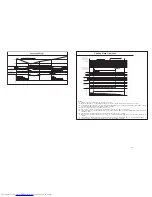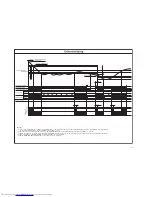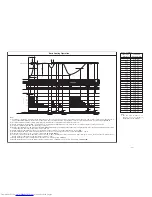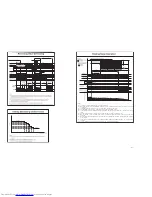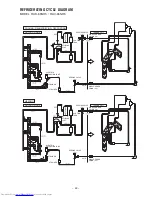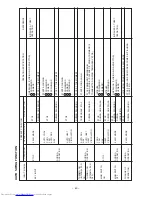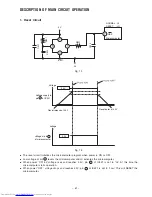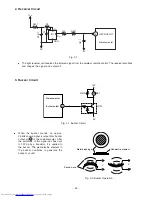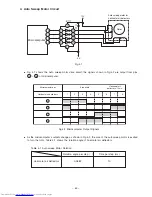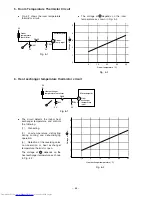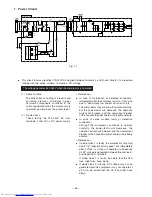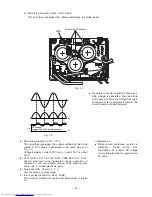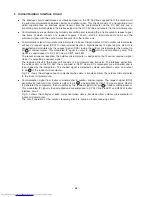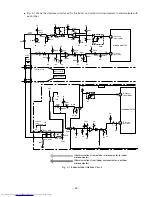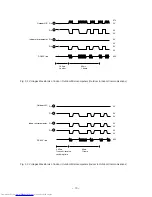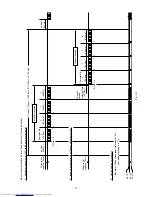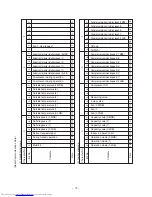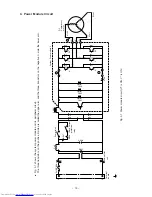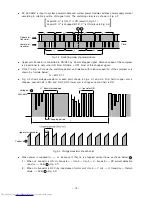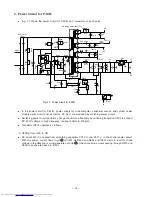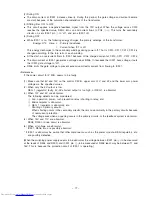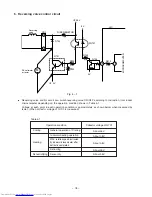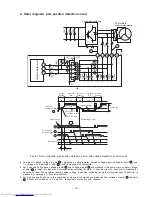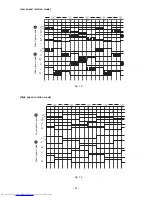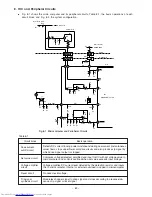
– 68 –
2. Indoor/Outdoor Interface Circuit
●
The interface circuit superimposes an interface signal on the DC 35V line supplied from the outdoor unit
to perform communications between indoor and outdoor units. This circuit consists of a transmiting circuit
which superimposes an interface signal transmit from the microcomputer on the DC 35V line and a
transmiting circuit which detects the interface signal on the DC 35V line and outputs it to the microcomputer.
●
Communications are performed by mutually transmiting and receiving the 4-frame outdoor request signal
one frame of which consists of a leader of approx. 100 ms., start bit, 8-bit data and stop bit and the
command signal with the same format transmit from the indoor unit.
●
Communication signal from outdoor microcomputer to indoor microcomputer. At first outdoor microcomputer
will send a request signal (SDO) to indoor microcomputer. A high-frequency IF signal approx. 38 KHz is
generated and modulated by the request signal (SDO) inside the outdoor microcomputer then output to
pin
11
of microcomputer. This modulated IF signal is output to pin
30
of HIC and amplified by amp. This
signal is superimposed to DC 35V line via C801 and L801.
To prevent erroneous reception, the outdoor microcomputer is designed so that it cannot receive a signal
while it is outputting a request signal.
The receiving circuit in the indoor unit consists of a comparator and transistor. The interface signal from
the outdoor unit on the DC 35V line is supplied to C821, where DC components are eliminated, and is
then shaped by the comparator. The shaped signal is detected by diode, amplified by amp, and output
to pin
49
of the indoor microcomputer.
Fig. 2-2 shows the voltages at each component when data is transferred from the outdoor microcomputer
to the indoor microcomputer.
●
Communication signal from indoor microcomputer to outdoor microcomputer. The request signal (SDO)
generates by indoor microcomputer is output to pin
50
, and amplifies by C801. IF signal approx. 38 kHz
is generated by comparator, then modulate by the request signal from pin
50
of indoor microprocessor.
This modulated IF signal is then amplified and superimposed to DC 35V line via L801 and C802 of indoor
interface circuit.
Fig. 2-3 shows the voltages at each component when data is transferred from outdoor microcomputer to
indoor microcomputer.
The circuit operation of the outdoor receiving circuit is same as indoor receiving circuit.
Summary of Contents for RAC-65NH5
Page 36: ...CIRCUIT DIAGRAM 37 ...
Page 37: ...CIRCUIT DIAGRAM MODEL RAC 65NH5 39 ...
Page 87: ... 99 SELF DIAGNOSIS LIGHTING MODE ...
Page 89: ... 101 2 Outdoor unit does not operate but receives remote infrared signal ...
Page 91: ... 103 6 Check the main P W B power circuit ...
Page 92: ... 104 CHECKING THE REMOTE CONTROLLER ...
Page 97: ... 109 ...
Page 107: ...HITACHI PM NO 0000E Printed in Malaysia RAK 65NH5 RAC 65NH5 ...


